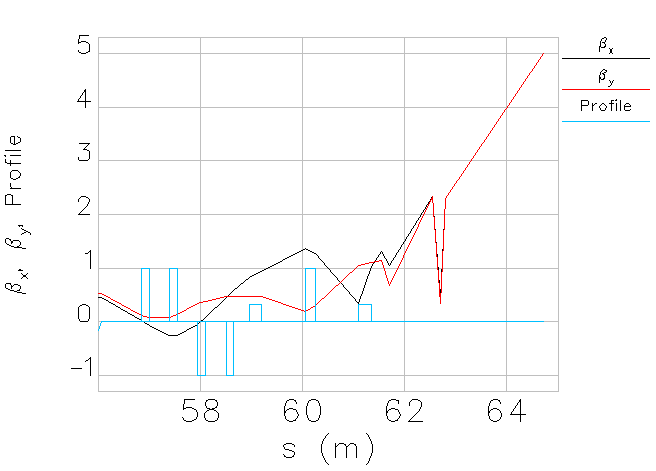bERLinPro
Recirculator & Dump Line
Recirculator
The recirculator transports the accelerated beam from the linac exit via a potential experiment back to the linac entry, where it is decelerated to recover the beam energy. The primary goal for its layout is a beam transport without significant losses while conserving the excellent quality of the beam. The recirculator is designed to have also compressor capabilities, required for the standard as well as for the short pulse mode.
Various beam physics aspects determine the layout of the recirculator:
• High transmission: In order to minimizing the loss rate a large transverse acceptance is required. Together with a sufficiently large vacuum chamber this is achieved by tuning the optics to moderate β-functions of a few tens of meters. A large longitudinal acceptance is realized by minimizing the dispersion function inside the achromatic arcs, by using four 45° dipoles. An achromatic setup has been choosen to eleminate dispersive beam size contributions outside the arcs.
• Variable R56: for the modest compression in standard mode the arc's are tuned to R56=+/-0.14m.For the short pulse mode stronger compression with larger R56 values is required. For a highly efficient energy recovery the recirculator as a whole is isochronously (R56 = 0) tuned
• Non-linear beam transport properties: higher order multi-poles can be used to correct for non-linearities du to rf curvature, space charge any other kind of wake field effects. Moreover, multi-pole magnets might be also required to optimize the transport of beam halo. Whenever implemented in the magnet lattice they require well separated Twiss parameters to be effective.
• Matching: To be able to tune the optics in arcs and in the straight sections independently, sufficient matching quadrupoles are foreseen, four each before and behind the two arcs.
The linear optics with its Twiss parameters is a weighted tradeoff between all the requirements.
Guiding the beam from the linac exit back to its entry could be achieved by a ring segment like a storage ring but the most compact shape is a racetrack structure. It consists of two 180° arcs connected by two straight sections: one accommodates the linac, the beam injection and extraction and in the other an experiment could be placed.
Various designs exist for 180° arcs: a single 180° bend, two 90° bends, three times 60°, four times 45° or the bates arc [2]. The 60° and 45° options were studied in detail. The 45° solution benefits from a lower maximum dispersion and better tuning properties due to the reduced vertical edge focusing of the dipoles and an additional quadrupole introduced between the central dipoles. The spatial requirements of the 45° arc lie only insignificantly above the 60° arc.
In order to suppress the dispersion outside the arcs and simultaneously to adjust a specific value of R56 at least two quadrupole families are required. A third one is introduced to adjust the Twiss parameters. Simulations show, that all quadrupoles are focusing in the horizontal plane, due to the implicit vertical focusing of the parallel faced dipoles. That’s why a fourth quadrupole is placed between the central dipoles to introduce variable vertical focusing. In this configuration the R56 can be tuned over a range much wider than required with respect to bunch compression issues, while keeping the arc achromatic at a low maximum dispersion and at acceptable beta function values.
To match the Twiss parameters between the arcs and the straight sections four individually powered quadrupoles are placed up- and downstream of each arc. Due to the limited drift space in between these quadrupoles their efficiency is limited. Investigations on reducing the number of matching quadrupoles are ongoing.
Four sextupole magnets per arc are foreseen to counteract for non-linear beam transport effects as described above.
Two achromatic dipole chicanes, composed of three dipole magnets each, are placed up- and downstream the linac. They compensate the deflection that the high energy beam experiences in the dipoles needed for the low energy beam for the injection into and the extraction out of the recirculator. The last dipole of the injector chicane is shared with the merger; the first one of the extraction chicane is shared with the beam splitter, guiding the ‘spent’ beam into the dump line. The deflections of the high energy beam are closed (no residual horizontal offset) so that the injection and extraction beam energy can be changed independent of the recirculator optics, except for the bump amplitude inside the chicane, which scales with the ratio between injection and recirculator energy. Between each chicane and the linac four short quadrupoles are placed to match the low energy beam into the linac and adapt to the BBU conditions. The effect of these quadrupoles on the high energy beam is not negligible.
Dump Line
The only task of the dump line is to safely transport the beam into the dump, capable to sustain the 650 kW peam power. Two contradictory requirements has to be met:
- safe, i.e. loss-less transport of the beam into the dump, which demands usually for small beam cross sections,
- a strong beam widening entering the dump to keep the power density on the dump surface below its destruction limit.
At the moment a set of two strong solenoids are used for the later purpose while the first part of the dumpline is tuned for large acceptance and small beam size.


